Galleries
David Ebony’s Top 10 New York Gallery Shows for May
Work by Carmen Herrera, Jessi Reaves, and Tracey Emin are on view.
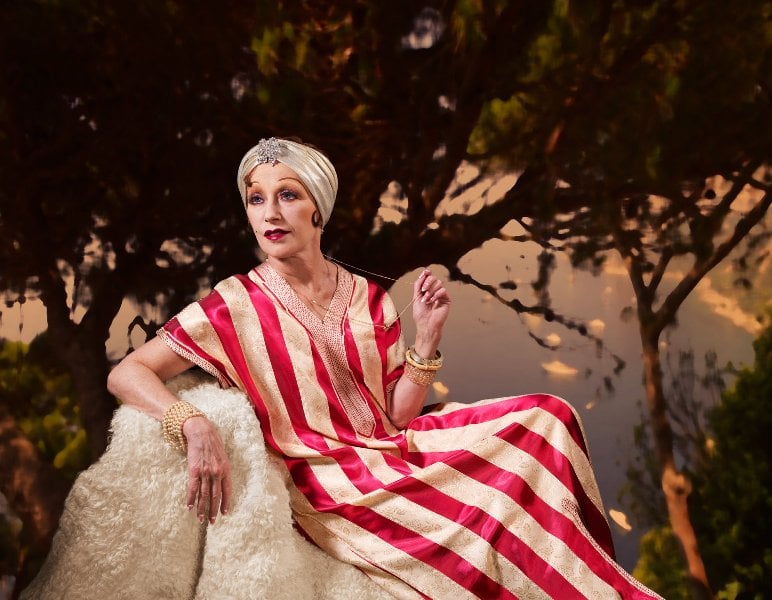
Work by Carmen Herrera, Jessi Reaves, and Tracey Emin are on view.

David Ebony

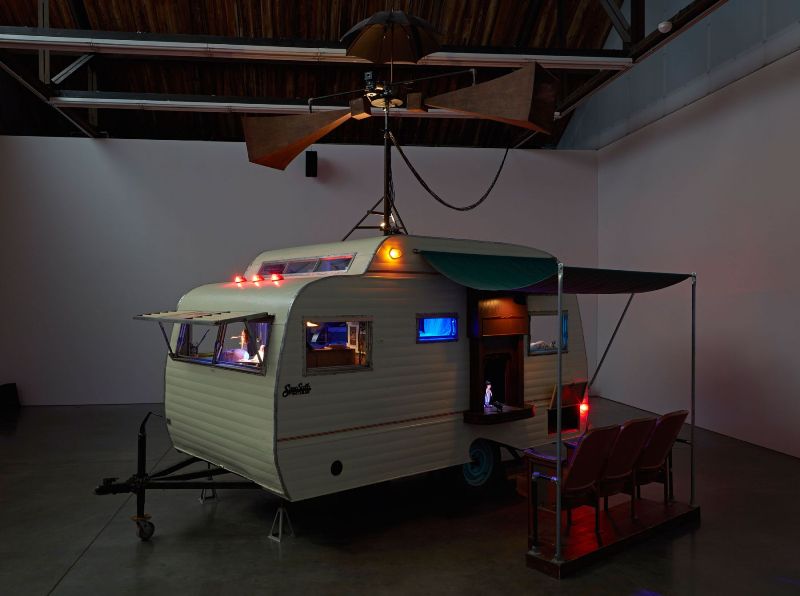
Installation view, Cardiff and Miller, “The Marionette Maker,” 2016.
Photo Courtesy Luhring Augustine.
1. Cardiff and Miller at Luhring Augustine, through June 11.
Known for elaborate, immersive installations with images and sound, Canadian collaborators Janet Cardiff and George Bures Miller have reached a milestone with this haunting exhibition. The show highlights just two major, monumental works: Experiment in F# Minor (2013) and The Marionette Maker (2014), making their New York debuts. Occupying the darkened main gallery, The Marionette Maker features what at first appears to be a small, derelict mobile home, topped by large, rotating old loudspeakers, like the kind used for outdoor PA systems in arenas or public gatherings. Emanating from these speakers are a variety of ambient noises, such as airplanes flying overhead, or the sound of pouring rain crashing on a metal roof in a thunderstorm.
As one approaches the camper, the interior spaces come alive with animated puppets, flashing lights, and tinkling music. It is the lair of the puppet master himself, ostensibly conjuring and creating the moving figures therein. Peering through the windows on all sides of the camper, viewers witness a dreamlike progression of images, culminating in the rear with a lifelike, and life-size female figure lying on a cot. Is she dead? After a pause to wonder, I decided that she must be fast asleep, lost in a dream state, no doubt. The effect is jarring and exhilarating.
In a rear gallery, Experiment in F# Minor is a kind of interactive musical instrument, featuring a large table topped with dozens of pulsating speakers. Motion sensors placed in the room trigger sounds emanating from the speakers. Visitors, therefore, as they move around the room, launch sad violin tones, choral strands, guitar riffs, or electronic sounds; it’s a rather New Age-sounding mix, all in the key of F# minor.
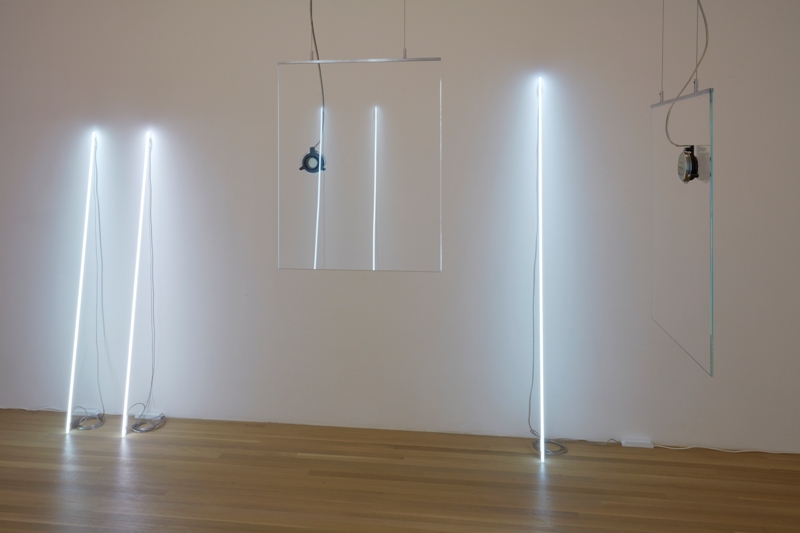
Installation view, Cerith Wyn Evans, “shade / frequency. . .” 2016.
Photo Courtesy Galerie Buchholz.
2. Cerith Wyn Evans at Galerie Buchholz, through June 25.
This exhibition, by Welsh-born artist Cerith Wyn Evans, “shade / frequency. . .” centers on how the body moves through space—the gallery, city street, a landscape, or any place for that matter, absorbing light, energy, sound and sensation. The show is cool, meditative, and quietly breathtaking. Arranged in the front galleries, thin tubes of neon about five to six feet tall, in subtly varying tones of white, in singles or in pairs, lean against the wall at slight angles. Initially, they recall certain pieces by artists such as Dan Flavin or Keith Sonnier, but the impact or effect of Evans’s work is unique. He refers to the series of neon elements as “Leaning Horizon,” or vertical horizon lines. They convey the feeling of instruments that might indicate latitude, direction, and the time of day. In the show, the air is filled with gentle, radiant energy, and also with ambient sounds. These peculiar, high-pitched squeaking noises emanate from small, rectangular panes of glass suspended from the ceiling and outfitted with microphones, which pick up the vibrations of air as a body moves near.
A rear gallery features a single tall tube of orange-red neon, leaning against the wall. In the center of the room, two potted plants, on slowly rotating platforms, more explicitly refer to nature and landscape. In an interview for Time Out London, in 2014, Evans said of his work, “It’s really about fluidity, about drifting through the space, about sounds drifting, images drifting. You’re moving from one place to another and that movement can happen physically but also emotionally.” Moving through “shade / frequency . . .” offers viewers precisely this kind of rare, contemplative reverie.

Cindy Sherman, Untitled, 2016.
Photo Courtesy the artist and Metro Pictures.
3. Cindy Sherman at Metro Pictures, through June 11.
“There’s nothing wrong with being fifty, unless you’re trying to act fifteen,” Joe Gillis famously admonishes Norma Desmond in Billy Wilder’s 1950 classic, Sunset Boulevard. In that caustic and celebrated film, Desmond, an aging silent-screen star, fiercely portrayed by Gloria Swanson, seeks help from screenwriter Gillis, played by William Holden, to stage a comeback in the role of a teenager (Salome). It’s all about battling the aging process, for the ages. There are numerous correspondences between that film and the striking new group of self-portrait photos by Cindy Sherman in this captivating show.
Her first exhibition of new work in five years, the show marks something of a comeback for the art star, now 62, whose career spans some four decades. Since Sherman first gained art-world notice with the now-iconic series Untitled Film Stills (1977-1980), it seems reasonable that she would now choose to explore the phenomena of aging via images of herself in the guise of film divas of yesteryear. In these colorful works, she recycles publicity photos of glamorous actresses of the 1920s and 30s, such as Swanson, Mary Pickford, Garbo, and Crawford, et al. Of course, Sherman brings them up to date in terms of large-scale, vivid color, digitized backgrounds, and an ultra-high-tech process of printing directly on metal, eliminating the need for traditional glass protection. The series is perhaps the artist’s most cohesive thematically, and the least acerbic or sardonic in tone. Without being overly sentimental, she conveys a rather moving statement about the onslaught of time. We all struggle to sustain a certain level of dignity as we grow older, so why not add a touch of glamour?
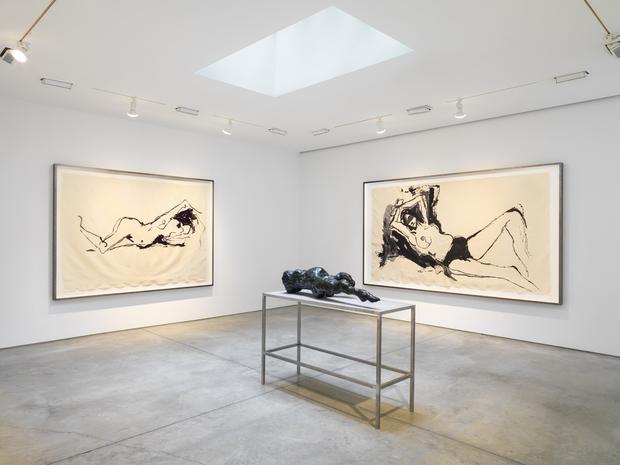
Installation view, “Tracey Emin: Stone Love,” 2016.
Photo Courtesy Lehmann Maupin Gallery.
4. Tracey Emin at Lehmann Maupin, through June 18.
Tracey Emin’s journey of self discovery continues to unfold in the dynamic new series of paintings, sculptures, embroidered pieces, works on paper, and text wall reliefs in neon featured in this engaging show. The exhibition’s title, “Stone Love” pays homage to the late great David Bowie, and was borrowed from the lyric to his song “Soul Love.” Most of Emin’s works in the exhibition center on an image of a single female nude—a self-portrait loosely based on recent photos that studio assistants have taken of her. In each work, the face is obliterated. “I don’t want it to be just about me,” Emin told the press at the show’s preview. In the work, she aims for a more universal feeling, a sense of being alone, but not exactly of loneliness. She says that after years of struggle, she has finally embraced the fact that she is without a life partner, and has devoted herself to her true passion, which is art.
Having just been honored with a well-received two-person exhibition with Egon Schiele at the Leopold Museum in Vienna last year, Emin is committed to ever more adventurous explorations of the figure. Unlike many other prominent contemporary artists, she prefers a hands-on approach, reveling in the tactile qualities of clay, as she forms the works that would be later cast in bronze, and the fluidity and chance properties of the painting medium. For her, art-making is a profoundly sensuous, life-affirming activity, incorporating a rather lofty ambition to uphold the long and noble tradition of figurative painting and sculpture.
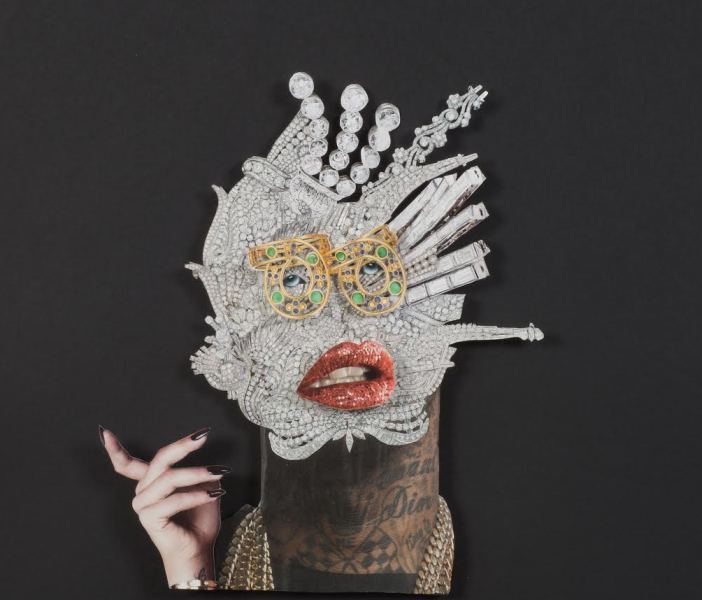
Rashaad Newsome, When You’re Talking to Someone and You Know They are Lying but You Keep Listening, detail, 2015.
Photo Courtesy De Buck Gallery.
5. Rashaad Newsome at De Buck Gallery, through June 25.
The hypnotic centerpiece of this exhibition of recent works by New Orleans-born New York-based artist Rashaad Newsome, the eponymous Stop Playing in My Face, is a four-minute video featuring a dazzling, kaleidoscopic merger of live action images and animated sequences. Continuously playing in a rear gallery, the film, with music by LA-based DJ and producer Hit Maker Chinx, is packed with flashing images of glittering jewels and gender-bending protagonists.
The pulsating, street-smart bling carries over to the large-scale collages in the main gallery, which expound upon black- and queer-culture themes. In the collages, fragmented photos of diamonds and gold form highly stylized, imaginative portraits. Set against black backgrounds, the centralized, heraldic images are often mounted in outlandish, thick, glossy black frames, such as the octagonal Yaaaaaaas! (2016), mimicking those of Dutch paintings of the Golden Age from the Metropolitan Museum of Art, which have inspired Newsome.
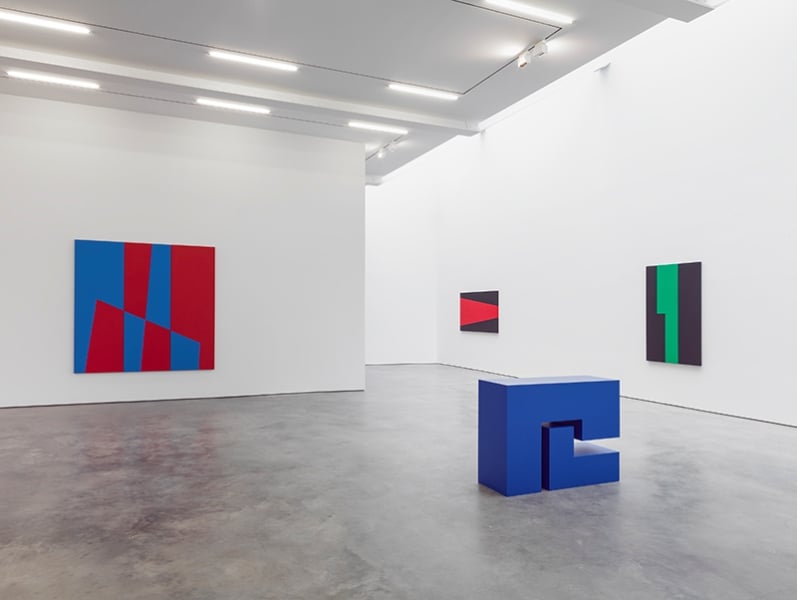
Installation view, Carmen Herrera, 2016.
Photo Courtesy Lisson Gallery.
6. Carmen Herrera at Lisson Gallery, through June 11.
Having flown under the radar for decades, New York painter Carmen Herrera, born in Havana, Cuba over 100 years ago, today finds herself to be something of a living legend. In September, the first major museum survey of her work opens at the Whitney Museum. Meanwhile, this radiant show of Herrera’s recent paintings and sculpture inaugurates the cavernous New York Chelsea outpost for London’s Lisson Gallery.
On view are 13 large, colorful, acrylic-on-canvas compositions, and one large-scale sculpture. Like many Latin American avant-garde artists of her generation, she was inspired by the Bauhaus, and works by abstract painters such as Piet Mondrian, Theo van Doesburg, and Max Bill. And her work corresponds to US artists like Ellsworth Kelly and Leon Polk Smith. Herrera’s reductive process allows just one or two hard-edge geometric shapes to dominate the canvas, and just two solid colors. Like her contemporary Bridget Riley, she designs the compositions on paper, which are later transposed to canvas by assistants. Herrera’s works, such as Blue and White (2014), with vertical bands of blue and white arranged in irregular intervals, trick the eye, and might suggest a work of Op art; but Herrera aims instead toward the architectonic.
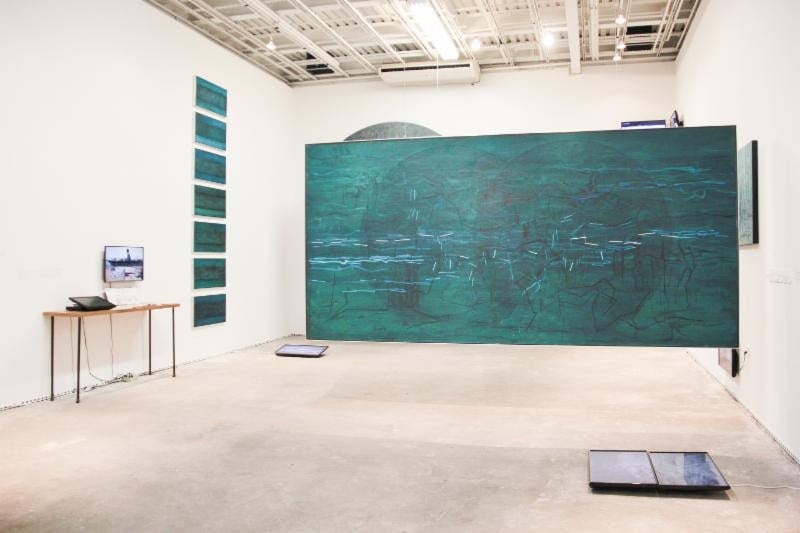
Installation View, Carlos Salas, “The Heart of the Matter,” 2016.
Photo Courtesy White Box.
7. Carlos Salas at White Box, through May 29
“The Heart of the Matter” a traveling exhibition of abstract paintings, photos, and video, is the striking New York solo debut for Colombian artist Carlos Salas. On view are large-scale canvases, such as the luscious, watery blue Traces of Feeling 1-3 (2010), suspended on wires several feet from the gallery floor. The muscular layering of aqua tones and fluid horizontal lines here might suggest a body of water, like a fast-moving stream or river. A large tondo, Into the Abyss (2014), dominates one wall; it features green tones with flourishes of blue, red, and gray jagged brushstrokes emanating from the center of the canvas. The composition hints at a cosmic explosion.
Salas’s emphasis, however, is consistently on the painting process itself, as he eschews notions of landscape, or any sort of pictorial attributes in the work. His thought process is revealed in an intimate documentary film produced by Ana Salas, the artist’s daughter, screening on a number of monitors scattered throughout the exhibition. Salas’s conceptual aims are clearest in A Sharp Dagger, a series of large photo works on view in a lower level gallery. Here, blow-up details of drawings shot through a magnifying glass offer perceptual challenges to distinguish between reality and artifice.
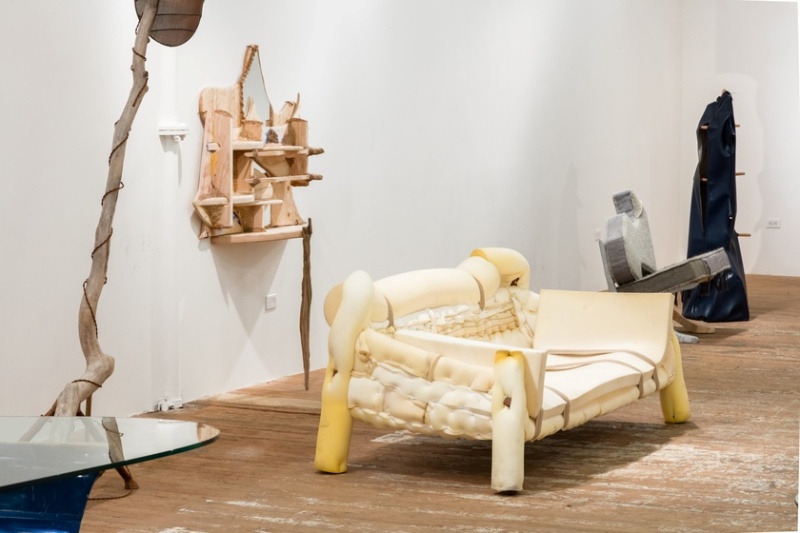
Installation view, Jessi Reaves, 2016.
Photo Courtesy Bridget Donahue.
8. Jessi Reaves at Bridget Donahue, through June 5.
Wacky and irreverent, but made with obvious conviction, Jessi Reaves’s furniture-like sculptures and objects constitute an impressive solo debut. Stepping into the gallery space conjures a visit to a modern furniture showroom. But on closer inspection, it might be a place where the Flintstones shopped. The archaic-looking, rough-hewn details and makeshift components of the would-be couches, coffee tables, armoires, and light fixtures are bizarre in the extreme. After spending some time in the show, however, the funky charm and humor of the work gives way to a keen intelligence, and even moments of beauty.
The Oregon-born New York artist makes puns on modern and contemporary art and design in a number of pieces. Mind at the Rodeo (XJ Fender Table Noguchi Knockoff #2), 2016, for example, mimics a Noguchi kidney-shaped glass-top coffee table, except that the base is made of a cut-up bumper from a Jeep Cherokee. One of my favorite works, Foam Couch with Straps (2016), echoes John Chamberlain’s foam rubber couches from the 1960s. Reaves’s nod to Chamberlain is certainly witty, but would anyone ever want to sit on this thing?
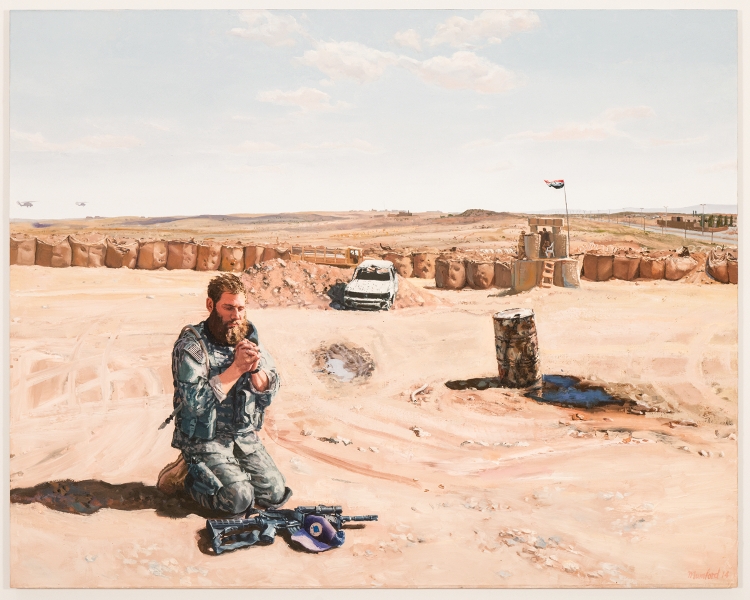
Steve Mumford, The Prayer, 2016.
Photo Courtesy Postmasters.
9. Steve Mumford at Postmasters, through June 18.
From 2003 to 2013, Steve Mumford made numerous trips to the war zones of Iraq and Afghanistan, and most recently visited the Guantanamo prison complex in Cuba. A self-styled “war artist,” Mumford chronicles the day-to-day tedium of war and the plight of soldiers, rather than the drama of war’s victorious or humiliating moments that make up the sensational TV sound-bites that are all too familiar to most US citizens. Sketching on site, he later transforms these works on paper into oil compositions on canvas with the help of photographs. The results are refined compositions of almost super-realist precision. This show of recent works is one of his most coherent and potent to date.
In one of the largest canvases, Anbar (2016), the Boston-born painter shows four soldiers in an open cockpit of a Blackhawk helicopter flying over a rural area of Iraq. The high-tech weaponry covering the soldiers contrasts jarringly with the mud shelters and rudimentary agriculture of the farm visible below. An unusual piece for Mumford, titled Text, bearing the words, “When I asked you how much sadness you have,” sets the tone for the show. One of the best works on view, The Prayer (2016), is a poignant statement about a war that is all about religion—and oil. A U.S. soldier kneels in the desert, machine gun on the ground, and hands clasped in prayer. On the right, there appears to be a leaky oil drum, and in the distance, berms and barriers intended to stave off insurgent attacks.
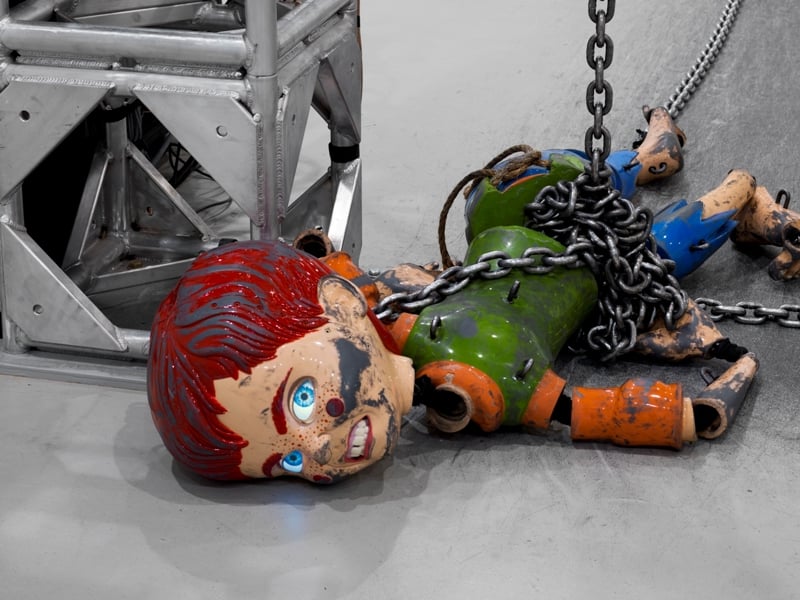
Jordan Wolfson, Colored sculpture (detail), 2016.
Photo Courtesy Sadie Coles HQ, London, and David Zwirner, New York.
10. Jordan Wolfson at David Zwirner, through June 25.
Compared with Cardiff and Miller’s gentle, dreamlike animatronics in The Marionette Maker, Jordan Wolfson’s heavy-metal puppet show, Colored sculpture (2016), while similarly riveting, is nightmarish, ferocious, and unsettling. The installation features a large, painted-metal robotic boy with red hair intended to conjure Howdy Doody, Alfred E. Neuman, or Huckleberry Finn, although for some viewers, a horror film creature like Chucky, or one of the Devil Dolls, will more likely come to mind. Suspended by chains connecting to a mechanized steel gantry, the weighty marionette moves about the space, lunging up toward the ceiling, and then abruptly crashes to the ground in violent, deafening upheavals. An extra scary touch is that the puppet’s eye sockets contain facial recognition technology, so that he appears to make eye contact with viewers and respond directly to them.
Periodically, speakers blast Percy Sledge’s 1966 hit, “When a Man Loves a Woman,” which adds a sense of humanity to the puppet, as if he is just all broken up over a botched relationship. The work’s manic, wanton aggression, however, strikes me as politically charged. It seems at times to reflect, for instance, the general anger and angst of a nation in the mist of an ugly presidential election. Jordan Wolfson has crafted a brilliant, monstrous work, wholly suited to our times. Colored sculpture may leave you scratching your head wondering, “What will they think of next?!” But you’ll be hard pressed to turn away from this piece until the computer-choreographed puppet has completed its approximately 15-minute dance macabre.
David Ebony is a contributing editor of Art in America and a longtime contributor to artnet.